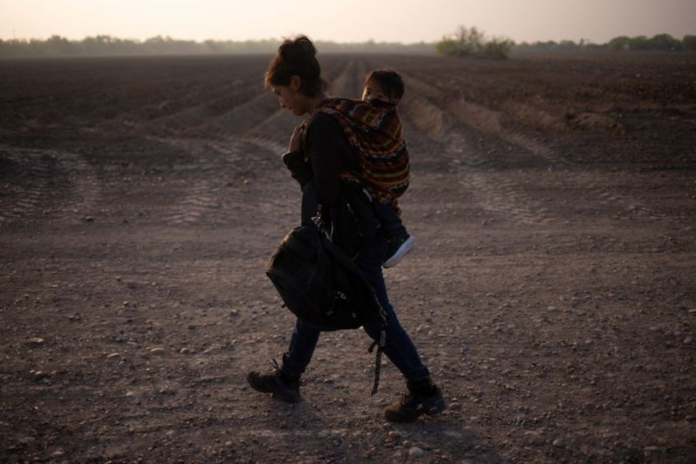
PENITAS, Texas (Reuters) – Mayra stepped from her hiding place in the dense brush on the banks of the Rio Grande, the river that marks the border between the United States and Mexico, as the sun came up on Wednesday morning. The 17-year-old migrant from Guatemala had her one-year-old son, Marvin, swaddled in a blanket on her back.
They had crossed the river hours earlier in the dark on small rafts with a group of about 70 migrants – mostly Guatemalan and Honduran women with young children and about 25 teenagers traveling alone. Mayra hoped that as a teen mother she would be allowed to stay in the United States.
- John Magufuli: Tanzania’s- president dies at age 61 after Covid rumours
- Covid: EU plans rollout of travel certificate before summer
The group is among thousands of migrants who have been crossing the U.S.-Mexico border in recent weeks, creating a political and humanitarian challenge for the new Biden administration as it tries to house the arriving migrants in government facilities during the coronavirus pandemic.
The number of migrants arriving at the U.S.-Mexico border this year is on pace to be the highest in 20 years, one of U.S. President Joe Biden’s top officials said this week. As of Tuesday, about 9,200 unaccompanied children were in custody of the Office of Refugee Resettlement, the government agency that houses migrant children.
Children’s clothes, shoes, and plastic water jugs littered the ground of the private ranchland in Penitas, south Texas, where Mayra’s group first made landfall after crossing the river, evidence of the migrants who had crossed in the days and weeks before them.
Now, the teens and parents set out on the final leg of their journey: walking to the U.S. border wall to wait for U.S. border patrol agents to take them into custody.
Mayra made her way down the dirt road in between cotton fields on the way to the tall, imposing rusted metal slats that make up the wall. Marvin grasped at her, exhausted and crying.
“I heard there was an opportunity to come,” she said. “I heard on the news that mothers with their babies and minors could come.”
When a neighbor offered to help pay for her journey, she felt she had no choice. Her father was dead and her mother’s health was starting to fail. She was earning only $5 U.S. dollars per day sowing corn, sometimes taking side work washing clothes. Marvin’s father had also disappeared. “He abandoned us,” she said through tears. “We have nothing.”
The group had spent the final night of their journey on the floor of an empty building on a farm near the river north of Reynosa, Mexico. “We slept like animals,” one young mother said.
‘NOW IT’S FINALLY REAL’
Word is spreading in Central America that minors and mothers of young children can enter the country, the migrants said, prompting them to take the weeks-long journey in buses, on foot, and in the back of trucks to arrive at the Rio Grande.
Biden says he wants to pursue a more humane immigration policy than the hardline policies of his predecessor, President Donald Trump. He has begun to allow in children who are not traveling with a parent or legal guardian, though he has left in place a Trump-era public health order that closed the border to the vast majority of asylum seekers.
Some families with young children have also been released in recent weeks into the United States in part because the local government of Tamaulipas across from southern Texas has refused to accept their return.
Still, Biden administration officials have urged migrants not to make the dangerous journey north, stressing that the border is not open and that most people crossing the border illegally will be deported.
Keiby, a 17-year-old Honduran, was the first among Mayra’s group to arrive at the border wall. There was an open gate with no patrol agents in sight, so she walked through and sat down to rest. She had heard she could be sent to a shelter for a few weeks before rejoining her family in the United States.
She was eager to get to her mother, whom she had not seen for 14 years. “It’s been all this time,” she said. “Now it’s finally real. Thank God.”
Members of the U.S. military arrived in a truck soon afterward and offered water bottles to the migrants. A border patrol truck pulled up and agents stepped out. “I would say we’re gonna need a bus,” one agent said. “It looks like there’s gonna be a lot of them.”
More agents arrived, separating out the unaccompanied minors, mostly teenagers, from those traveling as families, asking each migrant their age and nationality.
“You sure you’re a minor?” one asked a woman who said she was nearly 18. She looked older, he said, and it would be better for her to tell the truth now. She rummaged through her bag for a piece of paper that would prove her age.
Border patrol lined up the minors likely to be traveling without legal guardians against trucks and vans and sat the families up against the wall. They took down the children’s information, handing them bags to place their belongings in and instructing them to remove their shoelaces.
At the end of the line of minors stood Mayra, consoling her young son with a blue toy car. Overwhelmed and in tears, she nursed Marvin and waited for border patrol agents to approach her.
“I hope they’ll let me go to my sister,” she said.
She has family in New York and is eager to start a life there, to provide for her child and send money back to her mother in Guatemala to buy the medicine she needs.
Reporting by Mimi Dwyer, Editing by Ross Colvin and Aurora Ellis
Source: Reuters




